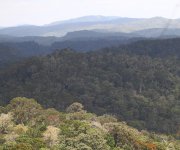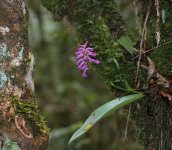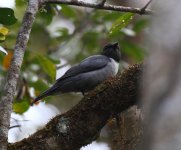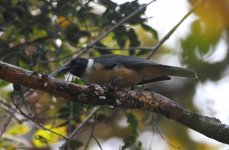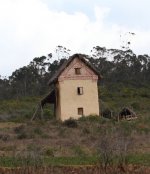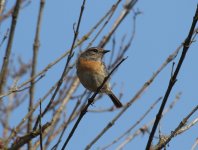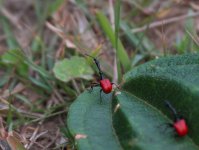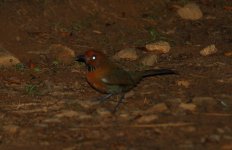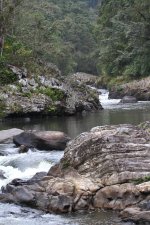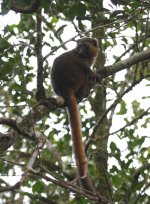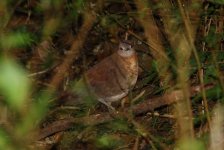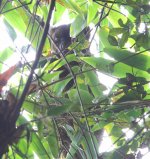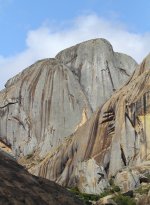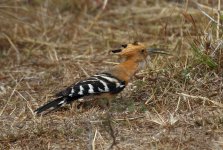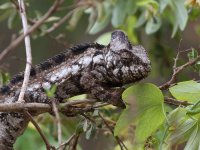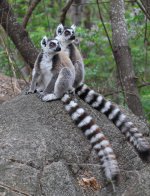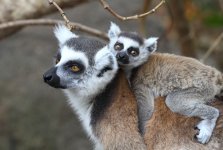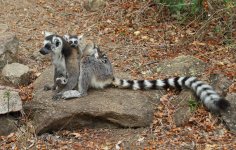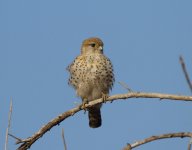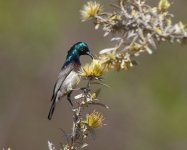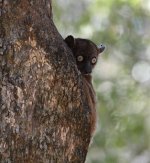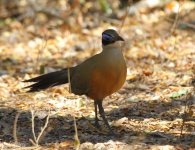edenwatcher
Well-known member
Nice Iain. My camera was on the wrong settings for that flock!
Wednesday 29th September. Part 1.
I woke after a less satisfactory night’s sleep to find a change in the weather, with overnight rain leading to overcast conditions and wispy cloud on the ridges. I ticked Chabert’s vanga, one of the commoner species, in the hotel grounds, whilst Iain was recovering from a nose bleed. The timetable was the same as the previous day except we were heading to the higher altitude trails at Vohiparara. Somehow on the drive up Fidi managed to spot a perched Madagascar buzzard. Being at higher altitude the forest at Vohiparara is rather lower and contains a somewhat different selection of species. Before we left the road a Chabert’s vanga appeared, so Iain got that one back very quickly. Not far along the trail a marshy area gave us another chance at Madagascar flufftail. This time the vegetation was less thick and with a combination of mp3 player and Iain’s voice recorder the little gem was coaxed into view. More new species swiftly followed including long-billed bernieria (greenbul), tylas vanga, grey-crowned tetraka (greenbul), Nelicourvi weaver, and white-throated oxylabes (the only one of this species I was to get a good look at). Madagascar wood rail remained skulking in the undergrowth however. As we reached a camp area, the recently described cryptic warbler was singing vigorously from a treetop perch. Not long after this, and just after encountering wedge-tailed jery, the heavens opened. This sent a Wings/Sunbird group heading for shelter, we were made of sterner stuff and pressed on. Fortunately the rain soon eased to a steady drizzle, making birding more feasible.
One of the main targets for the day was rufous-headed ground-roller – one of the more challenging members of the family to get to grips with. In the dark and dripping forest one began calling, which we lured in close to the trail. However the dense ground cover at that point didn’t do us any favours as Iain had a brief view and I got on to it just as it hopped out of view. It then retreated down the slope so we pressed on. Madagascar yellowbrow was the next Ranomafana speciality to fall, parading round us at close range (though often too fast to get the bins on!). Soon after this another ground-roller began calling and this time, after a bit of effort, brief views were obtained, followed by unobscured binocular-filling views of a calling bird! Iain suspects that he saw 2 individuals on this occasion. Rufous-headed ground-roller also occurs in Mantadia, but is perhaps harder there than at Ranomafana, so it was good to get this one on the list.
Next we climbed a narrow side trail up a ridge – our objective sunbird-asities. Fortunately the rain had stopped by this time as we stood around waiting for them to visit their favoured trees. In due course a superb male common sunbird-asity came and paid us a visit, but of the rarer yellow-bellied sunbird-asity there was not a sign. We were clearly not helped by the fact that none of their favoured flowers were blooming. On the way down we had our first tussle with brown emutail, an avian mouse. We had brief views as it scuttled and fluttered about before disappearing. Another ridge, another common sunbird-asity, but no yellow-bellied. Other birds seen included crested drongo and a vanga which Iain and I realised later was a female white-headed vanga; there were also some nice orchids. Descending towards the camp area another brown emutail performed rather better and we saw a close blue coua. The area around the camp harboured a mixed flock including blue and tylas vangas and Madagascar cuckooshrike. Fidi, in his enthusiasm to show Iain a white-headed vanga, actually pushed him off the bird! We were now on our way back to the road, and this time our attempts to see Madagascar wood rail met with success, the curious-looking beast scuttling to and fro in the undergrowth.
Rob
Wednesday 29th September. Part 1.
I woke after a less satisfactory night’s sleep to find a change in the weather, with overnight rain leading to overcast conditions and wispy cloud on the ridges. I ticked Chabert’s vanga, one of the commoner species, in the hotel grounds, whilst Iain was recovering from a nose bleed. The timetable was the same as the previous day except we were heading to the higher altitude trails at Vohiparara. Somehow on the drive up Fidi managed to spot a perched Madagascar buzzard. Being at higher altitude the forest at Vohiparara is rather lower and contains a somewhat different selection of species. Before we left the road a Chabert’s vanga appeared, so Iain got that one back very quickly. Not far along the trail a marshy area gave us another chance at Madagascar flufftail. This time the vegetation was less thick and with a combination of mp3 player and Iain’s voice recorder the little gem was coaxed into view. More new species swiftly followed including long-billed bernieria (greenbul), tylas vanga, grey-crowned tetraka (greenbul), Nelicourvi weaver, and white-throated oxylabes (the only one of this species I was to get a good look at). Madagascar wood rail remained skulking in the undergrowth however. As we reached a camp area, the recently described cryptic warbler was singing vigorously from a treetop perch. Not long after this, and just after encountering wedge-tailed jery, the heavens opened. This sent a Wings/Sunbird group heading for shelter, we were made of sterner stuff and pressed on. Fortunately the rain soon eased to a steady drizzle, making birding more feasible.
One of the main targets for the day was rufous-headed ground-roller – one of the more challenging members of the family to get to grips with. In the dark and dripping forest one began calling, which we lured in close to the trail. However the dense ground cover at that point didn’t do us any favours as Iain had a brief view and I got on to it just as it hopped out of view. It then retreated down the slope so we pressed on. Madagascar yellowbrow was the next Ranomafana speciality to fall, parading round us at close range (though often too fast to get the bins on!). Soon after this another ground-roller began calling and this time, after a bit of effort, brief views were obtained, followed by unobscured binocular-filling views of a calling bird! Iain suspects that he saw 2 individuals on this occasion. Rufous-headed ground-roller also occurs in Mantadia, but is perhaps harder there than at Ranomafana, so it was good to get this one on the list.
Next we climbed a narrow side trail up a ridge – our objective sunbird-asities. Fortunately the rain had stopped by this time as we stood around waiting for them to visit their favoured trees. In due course a superb male common sunbird-asity came and paid us a visit, but of the rarer yellow-bellied sunbird-asity there was not a sign. We were clearly not helped by the fact that none of their favoured flowers were blooming. On the way down we had our first tussle with brown emutail, an avian mouse. We had brief views as it scuttled and fluttered about before disappearing. Another ridge, another common sunbird-asity, but no yellow-bellied. Other birds seen included crested drongo and a vanga which Iain and I realised later was a female white-headed vanga; there were also some nice orchids. Descending towards the camp area another brown emutail performed rather better and we saw a close blue coua. The area around the camp harboured a mixed flock including blue and tylas vangas and Madagascar cuckooshrike. Fidi, in his enthusiasm to show Iain a white-headed vanga, actually pushed him off the bird! We were now on our way back to the road, and this time our attempts to see Madagascar wood rail met with success, the curious-looking beast scuttling to and fro in the undergrowth.
Rob




